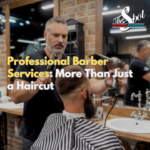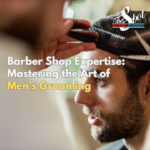Introduction
Hair loss is a common concern for men around the world. It can be a source of anxiety and a hit to self-confidence. However, with the right approach and expertise, thinning hair doesn’t have to be a setback. In this comprehensive guide, we’ll explore the causes of hair loss, how to prevent and manage it, and styling tips from seasoned barbers. We’ll also delve into how embracing and Navigating Hair Loss can be empowering and how you can turn your concern into a passion by joining a barbering program, such as the one at The Spot Barber Academy.

Refining Barbering Techniques for Thinning Hair
When it comes to managing thinning hair, barbers are the unsung heroes, equipped with a suite of techniques tailored to enhance the appearance of density and volume. Here are some detailed methods:
Strategic Shearing:
Barbers often employ the use of shears over clippers for thinning hair. Shears can be used to carefully cut and blend hair without removing too much volume. They allow for a more tailored approach, ensuring that each snip promotes the appearance of fullness.
Clipper Work:
While clippers may seem counterintuitive for thinning hair, the right guard size and technique can create a seamless transition in haircuts, reducing the contrast between thicker and thinner areas. Clippers can also add texture to the hair, which helps to mask the thinning areas.
Blending and Fading:
Expert barbers can blend different lengths seamlessly, which is particularly beneficial for those with thinning hair. A well-executed fade can draw the eye away from the thinning areas and towards a more styled, deliberate haircut.
Thinning Scissors:
Thinning scissors might sound alarming for someone with hair loss, but when used correctly, they can remove weight from thicker areas, balancing the overall look and making the thinning less apparent.
Directional Cutting:
Cutting the hair so that it lays in a direction that covers wider parts or thinning areas can also be a clever way to create the illusion of thickness. This technique requires a skilled hand to ensure the hair falls naturally and doesn’t appear forced.
Dry Cutting:
Cutting the hair while dry can give the barber a better understanding of how the hair naturally sits. This technique is ideal for fine or thinning hair as it allows for a more precise cut that takes into account the natural fall and cowlicks.
Incorporating Texture:
Creating texture on top can give the illusion of volume. Barbers often use point cutting or a razor to add texture to the hair, which can make it appear thicker and fuller.
Each of these techniques requires a deep understanding of hair behavior and a careful consideration of the individual’s hair type and loss pattern. It’s not just about cutting hair; it’s about crafting a look that gives the client confidence. By keeping up with the latest techniques and trends in barbering, professionals can offer sophisticated solutions for those with thinning hair.
Navigating Hair Loss and Prevention
While you can’t fight your genetics, there are proactive steps you can take to prevent or slow down hair loss. Maintaining a balanced diet rich in vitamins and minerals, staying hydrated, reducing stress, avoiding harsh hair treatments and chemicals, and not smoking can all contribute to healthier hair and scalp.
Barber Tips for Managing Thinning Hair
- Choose the Right Haircut: Work with your barber to find a style that suits the stage of your hair loss. Shorter haircuts can often make your hair appear fuller and more textured.
- Gentle Styling: Avoid tight hairstyles that pull on the hair and potentially exacerbate hair loss. Also, minimize the use of heat styling tools.
- Scalp Care: Use gentle, volumizing shampoos and conditioners. Scalp massages can stimulate blood flow and promote hair health.
- Ditch the Comb-Over: Embrace your natural hairline. A comb-over draws more attention to thinning areas.
- Color Wisely: Lighter shades can minimize the contrast between your hair and scalp, making thinning less noticeable.
- Consider Hair Growth Products: Minoxidil and Finasteride are two FDA-approved treatments that can slow Navigating Hair Loss and promote regrowth for some men.
Understanding Hair Loss: A Deeper Dive
Hair loss, or alopecia, can be a distressing condition that affects men of all ages. It’s not just about losing hair, but also about the psychological impact it can have. To effectively navigate this challenge, understanding the underlying causes is crucial.
Genetic Predisposition:
Often, hair loss is hereditary and encoded in your DNA. If your relatives have experienced balding, you’re more likely to do so as well. This type of hair loss usually follows a pattern, which is why it’s known as male pattern baldness or androgenetic alopecia.
Hormonal Changes:
Dihydrotestosterone (DHT), a derivative of the male hormone testosterone, is another common cause of hair loss. DHT can cause hair follicles to shrink, resulting in thinner hair and eventually hair loss.
Medical Conditions:
Conditions like thyroid disease, anemia, and protein deficiency can contribute to hair loss. Autoimmune diseases, where the body mistakenly attacks hair follicles, can also cause alopecia areata.
Medications:
Certain medications, including those for cancer, arthritis, depression, heart problems, and high blood pressure, may cause hair loss as a side effect.
Stress and Trauma:
Physical or emotional stress can lead to temporary hair loss. Telogen effluvium is a condition where stress pushes hair follicles into a resting phase, causing hair to thin and fall out.
Nutritional Deficiencies:
Lack of proper nutrition, especially deficiencies in iron, vitamin D, and protein, can affect hair health and growth.
Age:
As men age, the rate of hair growth can slow down, and the hair follicles may stop producing new hairs altogether.
Poor Hair Care:
Over-styling, high heat, harsh chemicals, and rough treatment can damage hair and exacerbate hair loss.
Understanding these factors is the first step in managing hair loss effectively. It sets the foundation for the selection of appropriate treatments, hairstyles, and care methods that can help maintain hair for as long as possible.
Embracing Hair Loss: Finding Confidence Beyond the Comb
Embracing hair loss is a journey towards self-acceptance that can be empowering and liberating. It’s about shifting the focus from what’s been lost to what can be gained.
Changing Perspectives:
The first step in embracing hair loss is a change in perspective. It’s not merely about acceptance but about redefining what hair represents in terms of personal style and confidence.
Confidence in Style:
Choosing the right haircut can make all the difference. A skilled barber can provide a cut that complements the shape of the head and face, making hair loss less noticeable and more stylish.
Scalp Care:
Taking care of the scalp is as important as hair care. A healthy scalp promotes the best possible environment for existing hair to thrive. Regular exfoliation, moisturization, and sun protection are key components.
Tattooing Techniques:
For some, embracing hair loss includes exploring scalp micro-pigmentation, a tattooing technique that creates the look of a shadow on the scalp, giving the illusion of a fuller head of hair.
Lifestyle Adjustments:
A balanced diet, regular exercise, and stress management not only improve overall health but can also benefit hair quality, potentially slowing the hair loss process.
Embracing Accessories:
Hats, scarves, and other accessories can become a part of a new, expressive style. They offer a way to accentuate personal fashion while embracing the new look.
Support Networks:
Finding support through online communities, support groups, or friends and family can provide a network of understanding and acceptance that reinforces confidence.
Navigating Hair Loss is a personal path that involves more than just dealing with the physical aspect; it’s about nurturing a state of mental well-being and finding a new way to express one’s identity. It’s a process that can lead to a renewed sense of self and an appreciation for the unique qualities that define each individual.

Advanced Hair Loss Solutions: Navigating the Frontier of Restoration
The world of hair restoration has expanded far beyond simple over-the-counter remedies. For those seeking advanced solutions to hair loss, there are several options that can offer hope and improved aesthetics.
Medical Interventions:
Medical treatments such as finasteride and minoxidil have been the mainstay for treating and Navigating Hair Loss, but newer medications and topical treatments continue to emerge, offering improved results with fewer side effects.
Hair Transplant Surgery:
Techniques in hair transplantation have progressed significantly. Follicular Unit Extraction (FUE) and Follicular Unit Transplantation (FUT) are surgeries that involve transplanting hair from denser areas of the scalp to the thinning areas, yielding natural-looking results.
Laser Therapy:
Low-level laser therapy (LLLT) is a non-invasive treatment that stimulates hair follicles to encourage growth. It’s an option for those looking for a drug-free solution.
Platelet-Rich Plasma (PRP) Therapy:
PRP involves drawing a person’s blood, processing it, and injecting the plasma into the scalp. It’s thought to promote healing and hair growth by using the body’s natural growth factors.
Scalp Micropigmentation (SMP):
For those who prefer a non-surgical approach, SMP can create the appearance of a shaved head or add density to thinning areas by depositing pigment into the scalp.
Hair Cloning and Multiplication:
While still in the experimental phase, these cutting-edge techniques aim to multiply hair follicles in a lab setting before implanting them into the scalp, potentially offering a limitless supply of hair.
Custom Hair Systems:
Modern hairpieces and systems have evolved and can provide an indistinguishable appearance from natural hair. These systems are tailored to fit seamlessly and can be a great non-invasive alternative.
Stem Cell Research:
At the forefront of hair loss solutions, stem cell research promises a future where baldness can be reversed by regenerating hair follicles. While not yet available, it represents a potential long-term cure and Navigating Hair Loss.
These advanced solutions require a thorough understanding and often a significant investment. However, they represent the cutting edge of hair loss technology and offer hope to those for whom traditional remedies have fallen short.
Regular Maintenance: The Cornerstone of Hair Health and Retention
Regular maintenance is crucial for managing the health of your hair and scalp, especially when dealing with thinning hair. Consistent care can help maximize the potential of the hair you have and maintain the scalp’s condition.
Scheduled Trims:
Even when hair is thinning, regular trims are beneficial. They help to remove split ends, prevent breakage, and maintain the shape of your hairstyle, which can make hair appear fuller and healthier.
Scalp Treatments:
Regular scalp treatments are vital. Products designed to exfoliate, moisturize, and nourish the scalp can keep it in optimal condition, supporting hair health and preventing further hair loss.
Gentle Styling Practices:
It’s important to avoid hairstyles that pull on the hair and can lead to traction alopecia. Adopting gentle styling techniques and using minimal heat can prevent additional stress on already thinning hair.
Quality Hair Care Products:
Investing in quality shampoos, conditioners, and styling products specifically formulated for thinning hair can make a significant difference. These products often contain nutrients that support hair strength and volume.
Diet and Supplements:
A regular regimen of hair-healthy nutrients, either through diet or supplements, can support hair growth. Biotin, zinc, iron, and vitamins A, C, and E are known for their roles in hair health.
Regular Check-ups:
Visiting a dermatologist or trichologist can provide insights into the health of your hair and scalp. These specialists can offer personalized advice and treatment plans for maintaining hair health.
Stress Management:
Chronic stress can exacerbate hair loss. Regular exercise, meditation, and other stress-reduction techniques can help maintain overall health and, by extension, hair health.
Sun Protection:
Protecting the scalp from the sun with hats or sunscreen is essential, especially for those with thinning hair, as the scalp is more susceptible to UV damage.
Maintaining a regular hair care routine is essential for those dealing with hair loss. It’s not just about preserving what’s left; it’s about fostering an environment where hair can thrive despite the challenges.
The Spot Barber Academy
If you’ve found a passion for barbering through your journey with Navigating Hair Loss, The Spot Barber Academy is where you can turn that passion into expertise. Our program is designed to teach you the skills needed to master the art of barbering, from classic cuts to modern styling techniques, including those for managing and embracing thinning hair.
Conclusion
Hair loss is a journey that many men navigate through their lives. By understanding the causes, taking preventive measures, and utilizing the styling tips outlined by professional barbers, you can confidently manage thinning hair. Remember, the key to rocking any style is confidence. If you’ve been inspired by the transformative power of a great haircut or want to empower others through their hair loss journey, consider honing your skills with us at The Spot Barber Academy. Our comprehensive barbering program is the perfect place to start your career, learn from the best, and join a community of professionals who understand the value of a great haircut. Embrace the change, and let’s create something amazing







